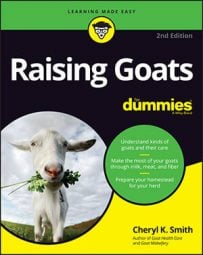If you're new to raising goats, you might not be sure that you're feeding them the right amount of food. Body-condition scoring is a way to determine whether a goat is in good health. You can use it to determine whether you're feeding correctly.
To determine body condition, you have to feel certain key points of the goat's body. The ribs and spine are the best indicators of body condition because the bones protrude there. Body condition scores (BCS) range from 1 (very thin) to 5 (obese). The ideal body condition score is a 3, although goats will be at 2 during certain times of the year, such as during rut, when the bucks forget to eat and run themselves ragged, or after a doe kids.
You have to practice body condition scoring to get good at it. Here are the guidelines for scoring a goat's body condition:
BCS 1: The goat is emaciated. The ribs, spine, and shoulder blades are sharp and pronounced. The space between each rib is quite visible because of lack of fat between them. The vertebrae are sharp and noticeable. The flanks are hollow and the sternum (above the front legs) has very little fat. The loin has no fat covering it.
BCS 2: The backbone is well defined but has some fat covering. The ribs are visible, but without a sunken area between them, and they're hard to feel where they come off of the sternum. You can feel a fat pad under the sternum, which you can move a bit. The loin is evenly covered with a small layer of fat.
BCS 3: The backbone is well-covered with fat, and the vertebrae don't feel sharp. You can feel a fat pad on the sternum that can't be moved much. The ribs are barely visible, but you can feel them. You can't feel the ribs where they come off the sternum without pressing hard and trying to find them. You can feel a smooth, even covering of fat over the loin.
BCS 4: You can't see the separate vertebrae in the spine. The sternal fat pad above the goat's front legs is thick and can't be moved. You have to search for ribs and can't feel the bones as they come off the sternum. The loin is covered with thick fat.
BCS 5: The goat is clearly obese. You can't feel any individual vertebra or ribs. You may even see dimpling and hanging fat on various parts of the body, particularly the sternal region. The loin area may be so thick with fat that it jiggles.
If you have one goat that's very thin and is having trouble getting enough food, try moving her to a separate pen for a little extra feeding each night. If you add grain, make sure to start slowly. If a goat is extremely thin, but seems to be eating all right, consider testing for a disease that causes wasting, such as Johne's or CAEV.
If you have a goat that is clearly obese, you'll probably find that the animal is first to the feed and getting more than his share. Move that goat to a separate pen during feeding time and limit his feed.

